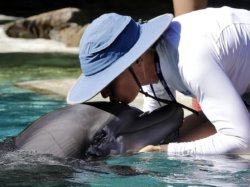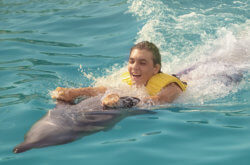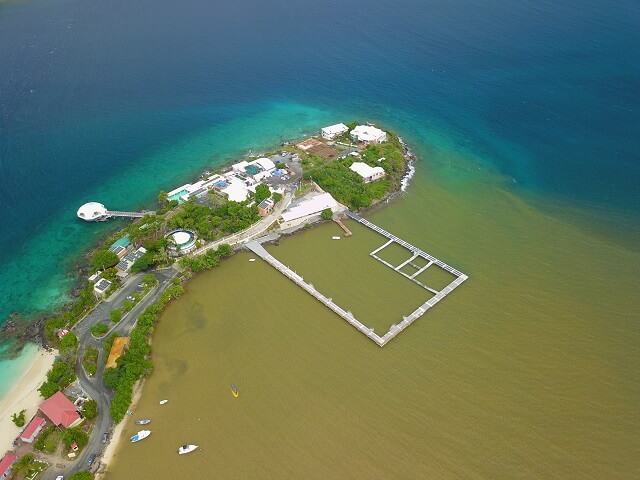Late in the night of Tuesday, February 19th, staff members at an entertainment facility in the desert outside of Phoenix loaded four dolphins onto a Penske rental truck and drove them to Sky Harbor Airport, where they were transferred to a plane bound for the U.S. Virgin Islands.
In the two years and four months since the grand opening of Dolphinaris Arizona, half of its eight dolphins had met untimely deaths: 7-year-old Bodie in September 2017; 10-year-old Alia in May 2018; 11-year-old Khloe in December 2018; and 22-year-old Kai just a month later.
Two of the remaining dolphins – Liko and Noelani – were on loan from Dolphin Quest, a resort in Hawaii, whose owners were telling Dolphinaris that enough was enough and that they wanted those two dolphins out of there immediately. Within days, the disgraced dolphinarium had taken down its sign, closed its doors, and arranged for Liko and Noelani to go to Coral World Ocean Park with the other two survivors of Dolphinaris: Sonny and Ping.
What killed Bodie, Alia, Khloe and Kai?

Dolphinaris Arizona before the sign was taken down
How could so many dolphins have died in such a short time? Dolphinaris has only released an “official” cause of death in the cases of Bodie and Alia, who are reported as having died of infections – common causes of death in captive dolphins. Khloe was said to have had a “chronic illness” but no details have been given. Nor has any information been released about Kai.
“The consequence of living in a tank amid an artificial grouping of other cetaceans and with the constant requirement to take part in performances leads inevitably to chronic stress,” explains Dr. Lori Marino, neuroscientist and President of the Whale Sanctuary Project. “This stress eventually wears down the immune system, making the animal vulnerable to all kinds of infectious pathogens. When contact with humans is added, as it is in ‘swim programs,’ there is not only more stress but also the very real risk of transfer of disease from human to dolphin and dolphin to human.”
Dolphinaris presented a “perfect storm” of such risks for the dolphins. Plus, there were serious concerns all along that the Arizona desert is a notorious hotspot for valley fever, a fungal infection caused by contaminated agricultural dust that could easily drift into the dolphin tank.
What’s next for the four surviving dolphins?

A behavior manager at Dolphinaris, AZ, kisses dolphin Liko. Photo by Matt York/AP
The four survivors have now been taken to a sea pen at Coral World Ocean Park in the U.S. Virgin Islands.
Coral World calls their sea pen a “sanctuary” – a word that’s generally defined as a “place of refuge.” By that definition, we would question whether any commercial facility fits that definition.
As we understand it, Coral World is planning to use these four dolphins in a Dolphin Experiences attraction where visitors interact with them. Coral World’s president and general manager, Trudie Prior, has said that the “the Dolphin Experiences are designed to provide visitors a unique opportunity to get up close and personal with our dolphins in a sea sanctuary setting.”
How does the Whale Sanctuary Project define a sanctuary?

“Hold on tight with the famous belly ride!” says the promo for a swim-with-dolphins experience at another Dolphinaris facility. “You can grab onto a dolphin’s fins while racing across the water at top speeds for a thrilling experience on the island of Cozumel.”
A true sanctuary strives to create the most naturalistic environment possible for the residents. It does not burden them with visitor “experiences” in which people are allowed to get “up close and personal” with the animals and to touch, feed or swim with them. “Encounters” with paying visitors are not part of a dolphin’s natural environment. Nor is having the animals participate in any form of entertainment for a human audience. Rather, at an authentic sanctuary, the autonomy of the residents is a priority.
Also, no authentic sanctuary breeds the animals in its care.
Is living in a sea pen better than living in a concrete tank?
Generally speaking and all else being equal, anything is better than life in a concrete tank. But a sea pen is not a sanctuary, and not all sea pens are equal. The Animal Welfare Institute notes that “the four remaining captive-born dolphins [from Dolphinaris] who are potentially immunocompromised, will be held in a sea pen enclosure in a bay known for its limited water circulation and poor water quality. Based on Clean Water Act monitoring, Water Bay is not fit for human swimmers 40 percent of the year. These four dolphins must live in this polluted water all day, every day.”

The sea pens at Coral World Ocean Park, demonstrating poor water quality in Water Bay, where the dolphins will be spending the rest of their lives, compared to the ocean beyond.
How we define an authentic sanctuary
As we continue our search for the best location for a whale sanctuary, here are some of the considerations that go into making that determination.
- An authentic sanctuary is not just a place to live but a place to thrive. It should be an example of a fundamental change in our relationship with cetaceans from one of exploitation to one of restitution.
- Sanctuaries do not offer public performances. They do not allow breeding. Nor do they permit any unnecessary invasive procedures. Rather, they promote autonomy and as natural a life as possible.
- They are fully transparent in their care of the animals and in the dissemination of health and behavior information.
And for an overview of the considerations as we evaluate sites of interest – including space, depth, water quality, environmental factors, and facilities, please check out this post. (Many thanks to our remarkable team of advisors for helping to compile these specs. They are among the world’s leading experts on the care of cetaceans.)
A whale sanctuary is a sanctuary for people, too
While there are no public performances at a sanctuary, that doesn’t mean there has to be a giant “Keep Out” sign at the entrance! A true sanctuary is a wonderful place for people to visit, a place of refuge where one can connect with nature and experience the animals in their own environment.
A sanctuary is also a place for education and inspiration where people, young and old, can appreciate how, when we give back to our fellow animals something of what we humans have taken from them, we experience something of inestimable value in return.
7 Comments
There were demonstrations months before trying to prevent the opening of the dolphin feature known as Dolphinarius. The desert soil holds a fungus that causes a thing called Valley Fever. It’s hard to detect, becomes a chronic disease in mammals and keeps our zoos from having chimps due to their suseptibility. The corporation ignored the pleas. I grieve for their death. This location in the Virgin Islands doesn’t look ideal either.
Thank you for educating us on what is going on with these dolphins. I am heartbroken by what greed and selfishness look like at the expense of these animals. Please keep us updated. I will help in whatever way I can….
Simply disgraceful and once again greed is the big factor here and not the well-being of their prize money generating Dolphins. Would you want to spend your life in that filthy water, no…No person or animal would want to be in a cesspool. SHAMEFUL and their need to be laws in place to make sure this is NOT repeated.
Well put. The situation with Dolphinaris Arizona is starkly juxtaposed with Merlin entertainment’s decision to ensure that their last remaining captives are able to live as natural a life as possible. Looking forward to the day when Little Grey and Little White will be reintroduced into a natural setting.
These dolphin’s lives have been improved, but a psuedo-sanctuary is still not good enough. Visitor interaction with the dolphins should be educational presentations on natural behaviour, and as this article states, no true sanctuary will allow breeding. This is a change for the better, but the dolphins are still being used as money making assets to an entertainment park.
I would love to see the eventual goal of the Whale Sanctuary Project become a reality – a place where ex-captive animals can live in a natural setting, and where humans can observe them much as they would on a conventional whale watching tour – from a distance that both prevents the animals residing at the sanctuary from being harassed and constantly on display, but still allows people to appreciate the natural beauty of these animals. This sanctuary will happen, it’s just a question of when. A question of how many cetaceans have to perish in captivity before the sanctuary is established. It won’t be a perfect place or a utopia – that would be the ocean – but it will be the least we can do for those creatures who are currently languishing in captivity.
I was outraged when they first brought the dolphins to AZ, where I live. Taking them out of that horrible environment took them too long and four beautiful animals were lost to greed and avarice. I wish there was a better and healthier solution for the remaining four as they deserve to be in a clean and safe environment and not used to entertain anyone!
I absolutely agree. A rushed transfer is not what was needed for these dolphins. They are not there for our amusement.